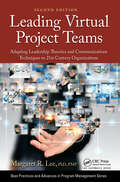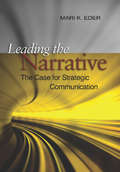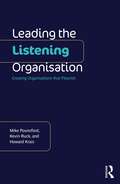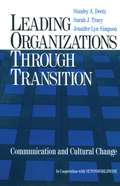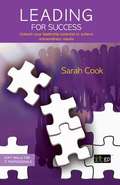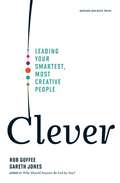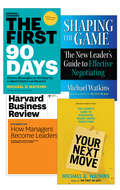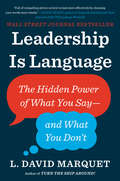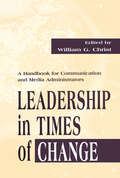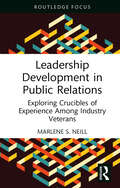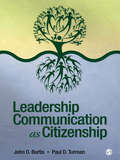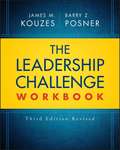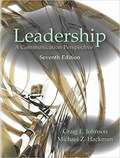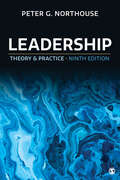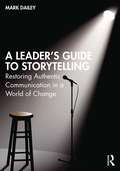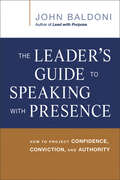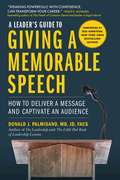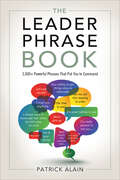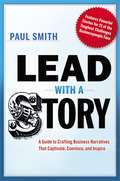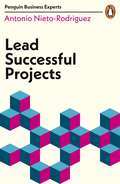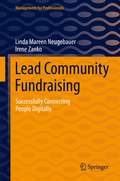- Table View
- List View
Leading Virtual Project Teams: Adapting Leadership Theories and Communications Techniques to 21st Century Organizations (Best Practices in Portfolio, Program, and Project Management #5)
by Margaret R. LeeThe second decade of the 21st century has brought unprecedented challenges to traditional workplaces. The global pandemic has forced the advance of working from home and telework. Individuals with little or no background or training in e-leadership, virtual project management, or virtual team management suddenly found themselves in the environment of virtual work. Leading Virtual Project Teams, Second Edition addresses the challenges that today’s virtual project management environment poses to traditional methods of leadership and communication. Leadership for successful virtual team management is different from that for traditional, collocated project team management. Explaining appropriate e-leadership styles for virtual project teams and the transition toward new leadership styles, the book is filled with communication techniques for leading virtual project teams. It helps project managers develop e-leadership competencies needed to successfully deliver projects in today’s organizations. The second edition also examines: Virtual meeting techniques Inclusive language Managing virtual relationships Why virtual work is now more important The work-at-home environment By recognizing how virtual teams are different from traditional teams, those managing virtual projects may be able to offer benefits to their organization by providing positive, successful leadership and exceptional communications, resulting in better project deliverables and products. This book provides an approach that explores all facets of e-leadership—from how traditional leadership theories and models can be applied by 21st century leaders to providing methods by which the virtual project manager can enhance virtual project communications to meet the needs of our modern global business world. It features project management checklists and templates and includes business cases, best practices, and tools and techniques for virtual project management communications.
Leading the Narrative
by Mari K. EderThe Strategy of Communication is a primer on the art and science of strategic communication. This book covers the foundation of communications strategies as well as solid tactics, techniques, and procedures for media relations, campaign planning, crisis communication and strategic communications planning. It is both a philosophy of communication and a solid practical reference manual. Like no other book on public relations, public diplomacy, or media operations and community outreach, it offers a compelling look at how all communication processes can be made to function more efficiently and with greater effectiveness. The ties are those of intention and purpose, both leading to meaningful and purpose-driven communication efforts, whether conducted by governments, organizations, or military units.From the most basic precepts of media relations interaction to massive information campaigns directed from the seat of government, communication that is broad-based, overarching and tied to strategic objectives can ultimately succeed using a variety of methods, from storytelling to building external champions. Practitioners and news media representatives alike should be aware of the nature of repetitive patterns in events, the power of myth in storytelling, and the significance of self-fulfilling prophesies. Influencing factors include new technologies that flatten communication hierarchies, social media platforms that empower amateurs, generational divides and a general decline in respect for the journalism profession and ebbing trust in the news as reported by the mainstream media. A coarsening of the public discourse throughout our celebrity-saturated culture likewise contributes to the difficulty of communicating with resonance and result in a toxic information environment. This book, a collection of collected essays on the communication practice, represents both a deeply passionate, strategically reasoned and thoroughly researched commentary on the field. It is both practical and theoretical.
Leading the Listening Organisation: Creating Organisations that Flourish
by Mike Pounsford Kevin Ruck Howard KraisHow organisations listen, learn, and adapt to their environment drives success and long-term sustainability. This book focuses on internal stakeholders and how employers can use the voice of their people to improve decision-making, innovation, and performance. It is about why listening to employees matters and how to do it well. Leading the Listening Organisation reveals not just the practices and processes that underpin effective listening but also the leadership characteristics and mindsets necessary to create resilient organisations that feel fair to work in, where people want to speak up, and where new ideas can flourish. It is based on extensive international research with leaders across over 500 organisations before, during, and after the pandemic. The authors bring decades of international experience and expertise in communicating with employees across public, private, and third sector organisations. Rich in practical tools, processes, and working frameworks and brought to life with case studies and insights from leaders and communicators, this book provides a complete guide to understanding the barriers to, and implementation plans for, leading a listening organisation. This comprehensive guide will resonate with leadership, internal communications, human resources, and organisational development professionals.
Leading Organizations through Transition: Communication and Cultural Change
by Stanley A. Deetz Dr Sarah J. Tracy Ms Jennifer Lyn SimpsonThis book addresses the role of communication in cultural change efforts within organizations, especially during periods of transition, mergers, technological innovations and globalization.
Leading for Success
by Sarah Cook"Leading for Success" is designed to assist IT managers in understanding the characteristics of an effective leader, to help them assess where their strengths and development areas are, and to create a plan of action for realizing their leadership potential.
Leadership Transitions: The Watkins Collection
by Michael D. WatkinsThis Harvard Business Review collection features the best in leadership transitions from celebrated author and advisor Michael D. Watkins. Watkins, who has worked for decades guiding senior leaders into new roles to help them and their organizations succeed, is the author of the international bestseller The First 90 Days. With more than 400,000 copies sold worldwide and published in more than 25 languages, the book has become the standard reference for leaders in transition.In addition to the full digital edition (ebook) of The First 90 Days, this collection includes digital editions of Watkins' other popular works: Your Next Move, which guides professionals through the most common career transitions; Shaping the Game, on how to lead effective negotiations; and his 2012 Harvard Business Review article, "How Managers Become Leaders."Watkins, whose ideas have guided some of the world's best leaders through successful transitions, is the chairman of leadership development consultancy Genesis Advisers. Drawing on the perfect combination of research and hands-on experience, he has spent the last two decades working with leaders-both corporate and public-as they transition to new roles, negotiate the future of their organizations, and craft their legacy as leaders. He was previously a professor at the Kennedy School of Government at Harvard, Harvard Business School, INSEAD in France, and IMD in Switzerland.
Leadership Resilience in a Digital Age
by Janette YoungThe book focusses on the challenges faced in the digital age, and the increasing demands for continuous change in an inter-connected digital world. The book presents stories about how leaders have faced significant challenges and pressure, and how they have used these experiences as catalysts to transform, flourish, and develop personal resilience. The book explores the digital journey, ethical issues, teamwork, styles of leadership, agile, collaboration, trust, culture, psychological safety, self-awareness, vulnerability, conversation, positivity, emotional intelligence, creativity, inner knowing and the dark side of leadership. Drawing on the experiences of leaders in the creative, digital and technology sectors in the UK, and using their voice throughout, has resulted in proposing several internal and external strategic solutions to help the reader become more personally resilient. The book explores the impact of continuous change within a digital age, presenting the facets necessary to become a Digital Sage in an increasingly chaotic world. With a focus on creativity, innovation and mind and body awareness the leader as a Digital Sage arises to encourage resilience in a digital age. The book does not assume prior knowledge of the field of resilience and is ideal for executive education courses, and for leaders and managers seeking personal and professional transformation.
Leadership Is Language: The Hidden Power of What You Say--and What You Don't
by L. David MarquetFrom the acclaimed author of Turn the Ship Around!, former US Navy Captain David Marquet, comes a radical new playbook for empowering your team to make better decisions and take greater ownership.You might imagine that an effective leader is someone who makes quick, intelligent decisions, gives inspiring speeches, and issues clear orders to their team so they can execute a plan to achieve your organization's goals. Unfortunately, David Marquet argues, that's an outdated model of leadership that just doesn't work anymore.As a leader in today's networked, information-dense business climate, you don't have full visibility into your organization or the ground reality of your operating environment. In order to harness the eyes, ears, and minds of your people, you need to foster a climate of collaborative experimentation that encourages people to speak up when they notice problems and work together to identify and test solutions. Too many leaders fall in love with the sound of their own voice, and wind up dictating plans and digging in their heels when problems begin to emerge. Even when you want to be a more collaborative leader, you can undermine your own efforts by defaulting to command-and-control language we've inherited from the industrial era.It's time to ditch the industrial age playbook of leadership. In Leadership is Language, you'll learn how choosing your words can dramatically improve decision-making and execution on your team. Marquet outlines six plays for all leaders, anchored in how you use language: • Control the clock, don't obey the clock: Pre-plan decision points and give your people the tools they need to hit pause on a plan of action if they notice something wrong. • Collaborate, don't coerce: As the leader, you should be the last one to offer your opinion. Rather than locking your team into binary responses ("Is this a good plan?"), allow them to answer on a scale ("How confident are you about this plan?") • Commit, don't comply: Rather than expect your team to comply with specific directions, explain your overall goals, and get their commitment to achieving it one piece at a time. • Complete, not continue: If every day feels like a repetition of the last, you're doing something wrong. Articulate concrete plans with a start and end date to align your team. • Improve, don't prove: Ask your people to improve on plans and processes, rather than prove that they can meet fixed goals or deadlines. You'll face fewer cut corners and better long-term results. • Connect, don't conform: Flatten hierarchies in your organization and connect with your people to encourage them to contribute to decision-making.In his last book, Turn the Ship Around!, Marquet told the incredible story of abandoning command-and-control leadership on his submarine and empowering his crew to turn the worst performing submarine to the best performer in the fleet. Now, with Leadership is Language he gives businesspeople the tools they need to achieve such transformational leadership in their organizations.
Leadership in Times of Change: A Handbook for Communication and Media Administrators (Routledge Communication Series)
by William G. ChristThis book addresses many of the issues facing new and seasoned communication and media administrators. Though there are business-oriented management and leadership books, there is no handbook--to the editor's knowledge--that emphasizes academic administration. This book fills an important gap in the literature by providing--in one place--interesting, important, and useful information that will help administrators by anticipating problems and suggesting strategies for the variety of challenges they face. This scholarly, anecdotal, useful, and very readable volume is conceived as an action handbook that contains philosophical, theoretical, and practical information. It is divided into three sections: background material, programmatic challenges facing administrators, and specific challenges facing administrators. It contains information that both the seasoned administrator and those faculty who are thinking about moving into administration will find useful. Although aimed at the communication and media disciplines, administrators in other fields will also find it valuable. In addition, deans and vice presidents outside the discipline who are responsible for communication and media programs will view the book a "must" read.
Leadership Development in Public Relations: Exploring Crucibles of Experience Among Industry Veterans (Routledge Research in Public Relations)
by Marlene S. NeillThrough interviews with members of the Public Relations Society of America College of Fellows, this book provides lessons on public relations leadership for the next generation.Often, our focus on high profile leaders is centered on success stories, but so much can be learned from the trials, or “crucibles,” they have faced and how leaders overcame and were shaped by these challenges. The Fellows interviewed represent a diverse group of accomplished professionals with specializations ranging from military public affairs and government, corporate, education, agency, and nonprofit organizations. A focus on ethical values, virtues, and ethical leadership will inspire readers to themselves confidently lead.This book will be of interest to advanced students in public relations programs or young professionals looking to forge their careers in public relations leadership.
Leadership Communication as Citizenship
by John O. Burtis Paul David TurmanLeadership Communication as Citizenship explains the communication skills you need to help construct effective experiences for an organization, team, or community, whether in the role of doer, follower, guide, manager, or leader. It articulates the important role that communication plays in helping to co-construct group, organizational, or community direction. Effective leadership communication is explored in the context of citizenship, emphasizing the opportunities and responsibilities we each face for helping groups that matter to us, whether a business, a religious institution, or a government entity.Throughout the book, authors John O. Burtis and Paul D. Turman relay a compelling, readable story about how to create more successful organizations and communities through direction-giving stories, regardless of one′s role in the group.Key FeaturesExplains the daily interplay between communication, citizenship, and direction-giving, thus challenging readers to realize the power they have to give direction in their own team, organization, or communityFocuses on common communication skills involved across seemingly disparate leadership contexts—from working in teams to communities to social movements or elsewhere—to help people succeed in the setting in which they find themselvesExplores times of crisis and use of leadership vision, discussing how direction-giving approaches may require adjustment in these times of extreme opportunity, threat, or change.Intended Audience: Leadership Communication as Citizenship is appropriate for anyone who wants to make a difference in their team, organization, or community, and for such courses as Leadership, Organizational and Group Communication, Industrial/ Organizational Psychology, Persuasion, and Management.
The Leadership Challenge Workbook (J-B Leadership Challenge: Kouzes/Posner)
by James Kouzes Barry Posner<p>The Leadership Challenge Workbook offers practical tools for applying The Five Practices of Exemplary Leadership® in real-life business situations. As the companion to The Leadership Challenge, this workbook provides essential hands-on guidance for planning, implementation, people-management, and more. This new revised third edition has been updated to match The Leadership Challenge Sixth Edition text. It includes easy-to-use worksheets to simplify planning and collectively assemble into a clear blueprint for moving forward. By focusing on the notion of leadership development as a journey rather than an event, this interactive guide provides critical insight through a proven, systematic process. <p>Implementing big ideas requires skillful change leadership—and any successful, sustainable change begins with thorough, practical planning. This workbook helps you map out a plan and put it into action, with tools that help clarify your thinking and translate your big ideas into concrete strategies.</p>
Leadership: A Communication Perspective
by Craig E. Johnson Michael Z. HackmanLeadership: A Communication Perspective has been at the forefront of university and college leadership courses for nearly three decades, providing a compelling, authoritative introduction to leadership as a communication-based activity. The new edition continues the tradition of excellence with an up-to-date treatment of theory and research combined with practical, real-world advice for improving communication competence and leadership effectiveness. The authors profile contemporary leaders and organizations like Alibaba's Jack Ma, Zappos' Tony Hsieh, Facebook's Sheryl Sandberg, Uber, The Container Store, Airbnb, Chipotle, the Waffle House, Nordstrom, and Google. Their presentation balances current scholarship and trends with historical perspectives to provide a fuller understanding of the study and practice of leadership. <p><p> Leadership and followership are examined in multiple contexts, including organizational leadership, public leadership, and leadership in groups and teams. Topics new to this edition include transcendent followership, the leadership skills approach, team coaching, escalation of commitment, invisible leadership, cultural intelligence, trigger events, and resilience.
Leadership: Theory and Practice
by Peter G. NorthouseAdopted at more than 1,600 institutions in 89 countries and translated into 15 different languages! The market-leading Leadership: Theory and Practice by Peter G. Northouse presents an academically robust account of the major theories and models of leadership with a focus on how theory can inform practice. Northouse uses a consistent structure for each chapter that allows readers to easily compare and contrast different theories. Case studies and questionnaires provide students with practical examples and opportunities to deepen their understanding of their own leadership style. The fully updated Ninth Edition features a new chapter on inclusive leadership, 17 new real-world cases that profile leaders from across the globe, a new discussion on leadership and morality, and examples of timely issues such as leadership during the COVID-19 pandemic. This title is accompanied by a complete teaching and learning package.
Leadership: Theory and Practice
by Peter G. NorthouseAdopted at more than 1,600 institutions in 89 countries and translated into 15 different languages! The market-leading Leadership: Theory and Practice by Peter G. Northouse presents an academically robust account of the major theories and models of leadership with a focus on how theory can inform practice. Northouse uses a consistent structure for each chapter that allows readers to easily compare and contrast different theories. Case studies and questionnaires provide students with practical examples and opportunities to deepen their understanding of their own leadership style. The fully updated Ninth Edition features a new chapter on inclusive leadership, 17 new real-world cases that profile leaders from across the globe, a new discussion on leadership and morality, and examples of timely issues such as leadership during the COVID-19 pandemic. This title is accompanied by a complete teaching and learning package.
Leadership: Leaders, Followers, and Environments
by Arthur PadillaLeadership is a “process,” not a person. In Leadership, author Art Padilla asserts that the dynamics of leadership involve leaders, followers and their environments—the organizational contexts within which leading and following take place. This triangle approach illustrates a more holistic and comprehensive view of leadership by focusing on all three dynamics.While infused with the most contemporary research and latest theories, material comes to life through chapter inserts and mini cases featuring themes that leaders and followers regularly encounter, such as: mentoring and developing talent, ethics, integrity and credibility, teams, and toxic leadership.Using the most current examples to demonstrate concepts, the author encourages students to perceive instances of leadership, and the leaders, followers and environments that make them relevant.
A Leader’s Guide to Storytelling: Restoring Authentic Communication in a World of Change
by Mark DaileyPart manual, part memoir and part call to action, this book demonstrates why the core skill needed by leaders in the next decade and into the future will be authentic and effective communication. Communications based on character, integrity and values will be critical in helping leaders navigate the two mega trends of accelerated technological change and increasing demands for social change. This book is the first to marry practical advice on deepening communication skills with insight from a coaching and cognitive point of view into what techniques works and why, and to pull together the wider societal issues and the operating context for leaders. Counter-intuitive and written to provoke thought and awareness, the author looks at the psychological and emotional effects of our communications and what leaders can do to inspire and engage, guiding them through three sections: • A framework for effective communications • A toolkit, detailing what good looks like in practical situations • The authentic leader, an exploration of the changing communications landscape and why a different kind of leadership is needed C-suite executives, leaders about to take that last step into the C-suite or millennial leaders about to enter the boardroom will value this book as an advisory guide, as a handbook to be used in internal coaching and training sessions and as a manual and aide memoir for themselves.
The Leader's Guide to Speaking with Presence: How to Project Confidence, Conviction, and Authority
by John BaldoniWhether in a meeting or a presentation, a watercooler conversation or a formal speech, a leader&’s most important job is to.Your idea may be groundbreaking. The potential profits might be exhilarating. The time to act may be right now, but if you&’re not able to craft and deliver a clear message that doesn&’t lead the audience to gain your perspective, that can be the difference between your pitch being transformational and becoming forgettable.Executive coach and leadership expert John Baldoni provides this concise tool kit containing more than 100 practical tips for creating and communicating meaningful messages with presence and authority.In The Leader's Guide to Speaking with Presence, you will discover how to:Present their ideas clearly and provide contextRadiate confidence and put the audience at easeRefine their deliveryUse stories to inform, involve, and inspireLeverage the energy of any roomConvey optimism tempered with reality to gain buy-inTurn PowerPoint presentations into performancesWhen a leader learns to own the room with an authentic and persuasive speech, the audience will become putty in their hands. The Leader's Guide to Speaking with Presence helps leaders achieve the kind of genuine presence that evolves into lasting trust and quantifiable influence.
A Leader's Guide to Giving a Memorable Speech: How to Deliver a Message and Captivate an Audience
by Donald J. PalmisanoExpert advice on delivering an unforgettable, stirring talk or lecture! &“Highly readable, immediately useful and deeply enjoyable!&” —John J. Nance, Aviation Analyst , ABC World News &“Insights on avoiding panic and other pitfalls, the use of rhetorical devices, and how to wow audiences from this masterful speaker who has done over 1000 speeches and interviews.&” —John N. Kennedy, United States Senator for Louisiana A good leader must be intelligent, charismatic, strong, and inspiring. A good leader must stir passion and instill knowledge in the minds of followers, whether in the field of business, medicine, politics, sports, or entertainment. A memorable speech is a powerful tool for demonstrating leadership and inspiring listeners for years to come. You can give a stirring, memorable speech, and be seen as a real leader, and Donald J. Palmisano can help you. Here Palmisano shares proven tips on delivering an inspiring and motivating speech. Drawing from his popular seminar at Tulane University School of Medicine and over 1,000 speeches and interviews, Dr. Palmisano teaches readers how to:Use rhetorical devices effectivelyStay on messagePractice deliveryGlean lessons from great speeches of powerful leaders from the past, such as Cicero, Winston Churchill, Dr. Martin Luther King, Jr., and Ronald ReaganOrganize speeches to emphasize the messageWeave in stories that are unforgettableAnd more!If you are a professor or teacher, if you are a CEO or manager, if you are thinking of running for office or trying to raise money, then A Leader's Guide to Giving a Memorable Speech belongs on your bookshelf. It's a great gift for anyone with aspirations of teaching, leading, or managing.
The Leader Phrase Book: 3,000+ Powerful Phrases That Put You In Command
by Patrick AlainEasily find the right words to respond like a leader in any situation, communicate effectively, and make your way to success.The Leader Phrase Book contains more than 3,000 dynamic phrases that will enable you to prevail in virtually all of life’s important situations. You will be in command of your words and always stay ahead of the game. With this passport to success, you will begin a new journey on which you are among the charismatic, the untouchable . . . the elite.This easy-to-use reference book will give you a new image you can take pride in helping you to quickly reach your full leadership potential. You will have all the weapons to effectively succeed whenever vibrant, forceful language is required. It works like magic!The Leader Phrase Book will teach you how to:• Speak like a leader• Master all conversations• Attain a charismatic presence• Gain the respect of others• Achieve a lightning-fast rhetoric• Find the right phrases instantly• Argue effectively• Be the envy of all you meetThe Leader Phrase Book is the culmination of ten years of Patrick’s personal research on how leaders communicate. It is the summation of his efforts to share one of the most invaluable skills in life: “how to put yourself in command.”Praise for The Leader Phrase Book“This refreshing and practical tool will help to enlarge, promote, and articulate the world of communication.” —Cristina Roggero, Pepperdine University professor of literature“An indispensable tool to help you become quickly fluent in phrases that put you ahead in the marketplace.” —Tony Azar, Homeland Security Chief Engineer“A must read for anyone who wants to move ahead in business.” —Jami Levesque, technical director of 300 and Transformers 3
Lead with a Story: A Guide to Crafting Business Narratives That Captivate, Convince, and Inspire
by Paul SmithStorytelling has come of age in the business world. Today, many of the most successful companies use storytelling as a leadership tool. At Nike, all senior executives are designated corporate storytellers. 3M banned bullet points years ago and replaced them with a process of writing strategic narratives. Procter & Gamble hired Hollywood directors to teach its executives storytelling techniques. Some forward-thinking business schools have even added storytelling courses to their management curriculum. The reason for this is simple: Stories have the ability to engage an audience the way logic and bullet points alone never could. Whether you are trying to communicate a vision, sell an idea, or inspire commitment, storytelling is a powerful business tool that can mean the difference between mediocre results and phenomenal success. Lead with a Story contains both ready-to-use stories and how-to guidance for readers looking to craft their own. Designed for a wide variety of business challenges, the book shows how narrative can help: Define culture and values Engender creativity and innovation Foster collaboration and build relationships Provide coaching and feedback Lead change And more Whether in a speech or a memo, communicated to one person or a thousand, storytelling is an essential skill for success. Complete with examples from companies like Kelloggs, Merrill-Lynch, Procter & Gamble, National Car Rental, Wal-Mart, Pizza Hut, and more, this practical resource gives readers the guidance they need to deliver stories to stunning effect.
Lead Successful Projects (Penguin Business Experts Series)
by Antonio Nieto-RodriguezAre you struggling to juggle multiple projects? Do you often lose control of your budget? Does communicating your progress to the rest of your team cause you undue stress? Project management is an essential skill for anyone who needs to get things done in any organisation, and is absolutely critical for anyone leading strategic change. In Lead Successful Projects, the Penguin Business Expert guide, Antonio Nieto-Rodriguez introduces a simplified but strategic approach to project management developed over the last 20 years coaching executives, managers and MBAs.Learn how to break down your project into manageable elements, define smart goals and meet them in this concise and practical guide to project success.
Lead from the Heart: Transformational Leadership for the 21st Century
by Mark C. CrowleyIf you're a leader in America, you've got a big problem. More than half of all workers hate their jobs. In fact, job satisfaction and employee engagement have been declining for twenty-two straight years. One hundred years ago, a job and a paycheck kept workers satisfied. Now, pay barely makes the list. Employees' needs have evolved dramatically. But our leadership practices have failed to keep up. In Lead From The Heart, Mark C. Crowley presents compelling new evidence that the solution leaders need lies in the last place traditional business would seek it: the human heart. Twenty-first-century employees need to feel... valued, respected, developed, and cared for. Their work has to matter. Recent scientific discoveries tell us that it's the heart, and not the mind, that drives human performance and achievement. Drawing on decades of experience as a senior leader for regional and national financial institutions, Mark C. Crowley offers proof that leaders who intentionally engage the hearts of their employees will be rewarded with uncommon (and highly sustainable) performance and achievement.
Lead Community Fundraising: Successfully Connecting People Digitally (Management for Professionals)
by Linda Mareen Neugebauer Irene ZankoThe world is changing, and so are our donors. In the future, it will become even more important for organizations to find leads, supporters and new donors online - because digitization is a bottleneck in fundraising.This book highlights universal fundraising opportunities. It explains the fundamentals of lead community fundraising and why, especially in digital times, it is important to start with the people - the community. The main topic of the book is the current state of digital fundraising, which is becoming more and more important. More than 45 examples from international fundraising practices provide a valuable foundation for all practitioners in this field.
